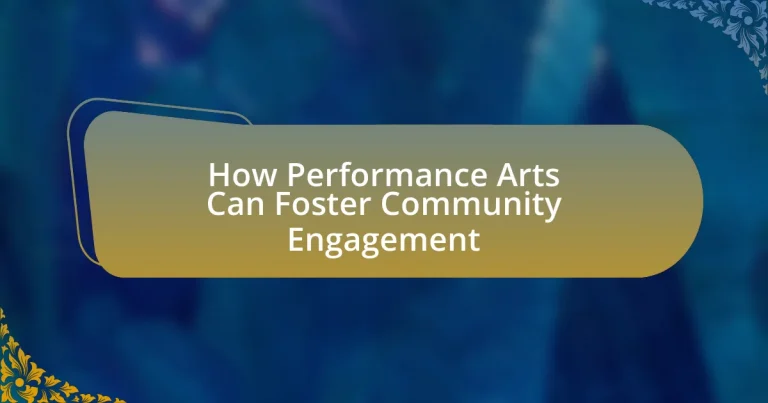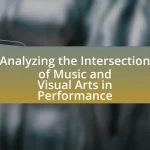Performance arts play a crucial role in fostering community engagement by enhancing social connections and cultural identity. Various forms of performance arts, including theater, dance, music, and spoken word, serve as platforms for individuals to share experiences and build relationships, leading to increased social cohesion and civic participation. The article explores how these art forms promote social interaction, unite diverse groups, and influence community bonding, while also addressing the importance of accessibility, funding, and cultural relevance in engaging underserved communities. Additionally, it highlights effective strategies for collaboration, outreach, and the use of technology to enhance community involvement in performance arts initiatives.
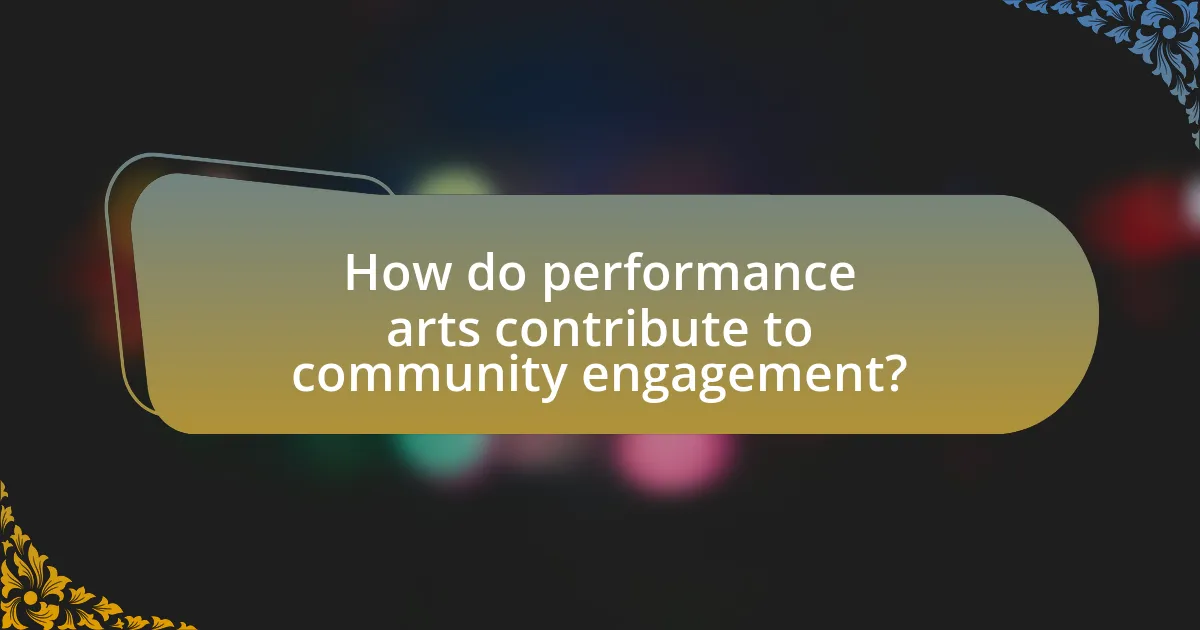
How do performance arts contribute to community engagement?
Performance arts contribute to community engagement by fostering social connections and enhancing cultural identity. Through events such as theater productions, dance performances, and music festivals, individuals come together, share experiences, and build relationships. Research indicates that communities with active performance arts programs report higher levels of social cohesion and participation in civic activities. For example, a study by the National Endowment for the Arts found that participation in arts activities correlates with increased volunteerism and community involvement, demonstrating that performance arts serve as a catalyst for collective action and community pride.
What are the different forms of performance arts that foster community engagement?
Different forms of performance arts that foster community engagement include theater, dance, music, and spoken word. Theater often involves local actors and stories that resonate with community experiences, creating a shared cultural dialogue. Dance, particularly community dance projects, encourages participation and collaboration among diverse groups, enhancing social bonds. Music, especially through community choirs or local bands, brings people together for collective enjoyment and expression. Spoken word events provide a platform for individuals to share personal narratives, fostering understanding and connection within the community. These forms of performance arts not only entertain but also serve as vital tools for social cohesion and cultural expression.
How do theater and drama promote social interaction within communities?
Theater and drama promote social interaction within communities by providing a shared space for individuals to engage in storytelling and collective experiences. These performances often reflect local culture and issues, fostering dialogue among diverse groups. For instance, community theater projects encourage participation from various demographics, enhancing social cohesion and understanding. Research by the National Endowment for the Arts indicates that participation in the arts, including theater, leads to increased social capital, as individuals form connections and networks through collaborative efforts in productions. This interaction not only strengthens community ties but also encourages empathy and cultural exchange among participants and audiences.
What role does dance play in bringing diverse groups together?
Dance serves as a powerful medium for uniting diverse groups by fostering shared experiences and cultural exchange. Through communal participation in dance, individuals from various backgrounds can connect emotionally and socially, breaking down barriers of language and cultural differences. Research indicates that dance events, such as community festivals or workshops, encourage collaboration and interaction among participants, enhancing social cohesion. For instance, studies have shown that dance programs in multicultural settings lead to increased understanding and appreciation of different cultures, as seen in initiatives like the Dance for All program in South Africa, which promotes inclusivity and cultural dialogue.
How does music influence community bonding and participation?
Music significantly influences community bonding and participation by fostering shared experiences and emotional connections among individuals. When communities engage in musical activities, such as concerts, festivals, or local performances, they create a collective identity that enhances social cohesion. Research indicates that communal music-making, like singing in choirs or playing in bands, promotes teamwork and collaboration, which are essential for building strong community ties. For instance, a study published in the Journal of Community Psychology found that participation in community music programs led to increased feelings of belonging and improved social networks among participants. This evidence underscores the role of music as a catalyst for community engagement and collective participation.
Why is community engagement important in the context of performance arts?
Community engagement is important in the context of performance arts because it fosters inclusivity and strengthens social bonds. Engaging the community in performance arts allows diverse voices to be heard, promoting cultural exchange and understanding. Research shows that community-based arts initiatives can enhance social cohesion, as evidenced by a study published in the Journal of Community Engagement and Scholarship, which found that participation in local arts programs significantly increased community members’ sense of belonging and connection. This engagement not only enriches the artistic experience but also empowers individuals, creating a vibrant cultural landscape that reflects the community’s identity.
What are the social benefits of increased community engagement through performance arts?
Increased community engagement through performance arts fosters social cohesion and enhances community identity. This engagement allows individuals to connect with one another, share experiences, and build relationships, which can lead to a stronger sense of belonging. Research indicates that communities with active performance arts programs report higher levels of social trust and lower crime rates, as seen in studies conducted by the National Endowment for the Arts. Furthermore, participation in performance arts can improve mental health and well-being, as it provides an outlet for self-expression and creativity, contributing to overall community resilience.
How does community engagement through performance arts enhance cultural identity?
Community engagement through performance arts enhances cultural identity by providing a platform for individuals to express and celebrate their unique cultural narratives. This engagement fosters a sense of belonging and pride among community members, as they actively participate in performances that reflect their traditions, values, and histories. For instance, studies have shown that community theater projects often incorporate local folklore and customs, which not only preserve these cultural elements but also educate participants and audiences about their significance. Additionally, events like cultural festivals that feature dance, music, and theater allow diverse groups to share their heritage, promoting intercultural dialogue and understanding. This interaction reinforces cultural identity by validating and showcasing the richness of various traditions within the community.
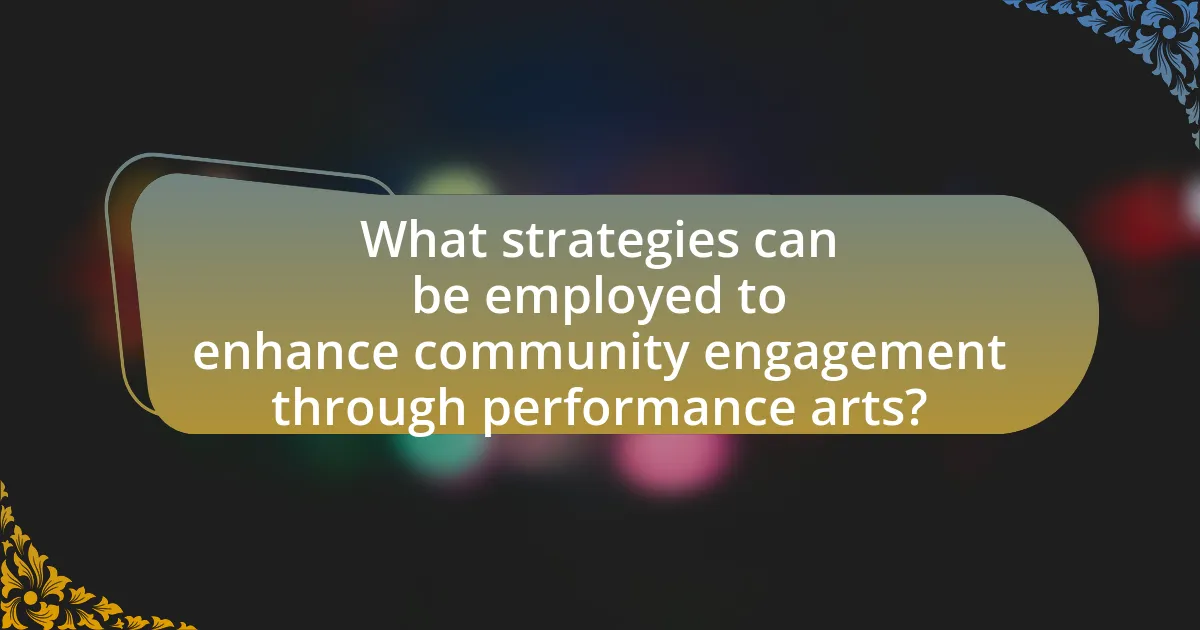
What strategies can be employed to enhance community engagement through performance arts?
To enhance community engagement through performance arts, strategies such as collaborative projects, inclusive programming, and outreach initiatives can be employed. Collaborative projects, where local artists partner with community organizations, foster a sense of ownership and connection among participants. Inclusive programming that reflects the diverse cultural backgrounds of the community encourages broader participation and representation. Outreach initiatives, such as workshops and performances in public spaces, increase accessibility and invite community members to engage directly with the arts. Research indicates that communities with active performance arts programs report higher levels of social cohesion and civic participation, demonstrating the effectiveness of these strategies in fostering engagement.
How can local organizations collaborate to promote performance arts?
Local organizations can collaborate to promote performance arts by forming partnerships that leverage shared resources, expertise, and audiences. For instance, community theaters, schools, and cultural institutions can co-host events, share venues, and cross-promote performances to enhance visibility and attendance. Research indicates that collaborative initiatives, such as joint marketing campaigns and combined programming, can increase audience engagement by up to 30%, as evidenced by the success of the “Arts in the Park” initiative in various cities, which brought together multiple local arts organizations to create a unified arts festival. This approach not only maximizes outreach but also fosters a sense of community ownership and participation in the arts.
What are effective ways to involve community members in performance art projects?
Effective ways to involve community members in performance art projects include organizing workshops, creating collaborative performances, and facilitating open forums for feedback. Workshops allow community members to learn skills and contribute creatively, fostering a sense of ownership. Collaborative performances enable participants to share their stories and perspectives, enhancing the project’s relevance to the community. Open forums for feedback encourage dialogue, ensuring that the art reflects community values and interests. Research shows that projects incorporating community input lead to higher engagement and satisfaction, as evidenced by studies conducted by the National Endowment for the Arts, which highlight the positive impact of participatory art on community cohesion.
How can funding and resources be secured for community performance initiatives?
Funding and resources for community performance initiatives can be secured through a combination of grants, sponsorships, crowdfunding, and partnerships with local businesses and organizations. Grants from government bodies and arts foundations often provide substantial financial support; for example, the National Endowment for the Arts offers various funding opportunities specifically for community-based projects. Sponsorships from local businesses can also be beneficial, as they may seek to enhance their community presence and brand visibility. Crowdfunding platforms like Kickstarter or GoFundMe allow community members to contribute directly to initiatives they support, fostering a sense of ownership and engagement. Additionally, forming partnerships with local organizations can lead to shared resources and funding opportunities, as seen in successful collaborations between arts organizations and community centers.
What role does technology play in fostering community engagement in performance arts?
Technology plays a crucial role in fostering community engagement in performance arts by enhancing accessibility and interaction. Digital platforms enable artists to reach wider audiences through live streaming, social media, and online ticketing, allowing participation from diverse community members regardless of geographical barriers. For instance, during the COVID-19 pandemic, many theaters transitioned to virtual performances, which resulted in a 300% increase in audience reach for some organizations, demonstrating how technology can expand engagement. Additionally, interactive technologies such as augmented reality and mobile applications facilitate audience participation, creating immersive experiences that deepen community involvement in the arts.
How can social media be utilized to promote local performance arts events?
Social media can be utilized to promote local performance arts events by creating targeted campaigns that engage the community and increase visibility. Platforms like Facebook, Instagram, and Twitter allow event organizers to share event details, behind-the-scenes content, and interactive posts that encourage audience participation. For instance, using Facebook Events can help reach local audiences effectively, as it allows users to RSVP and share the event with their networks, thereby amplifying reach. Additionally, Instagram Stories and Reels can showcase performances and artist interviews, generating excitement and anticipation. According to a study by the Pew Research Center, 69% of adults in the U.S. use social media, making it a powerful tool for reaching diverse demographics and fostering community engagement around local arts events.
What are the benefits of virtual performances for community engagement?
Virtual performances enhance community engagement by increasing accessibility and fostering inclusivity. These performances allow individuals from diverse backgrounds to participate regardless of geographical or physical limitations, thereby broadening the audience base. For instance, during the COVID-19 pandemic, virtual concerts and theater productions reached millions who otherwise could not attend in-person events, demonstrating a significant increase in audience engagement. Additionally, virtual platforms facilitate real-time interaction through chat features and social media, enabling community members to connect and share experiences, which strengthens social bonds.
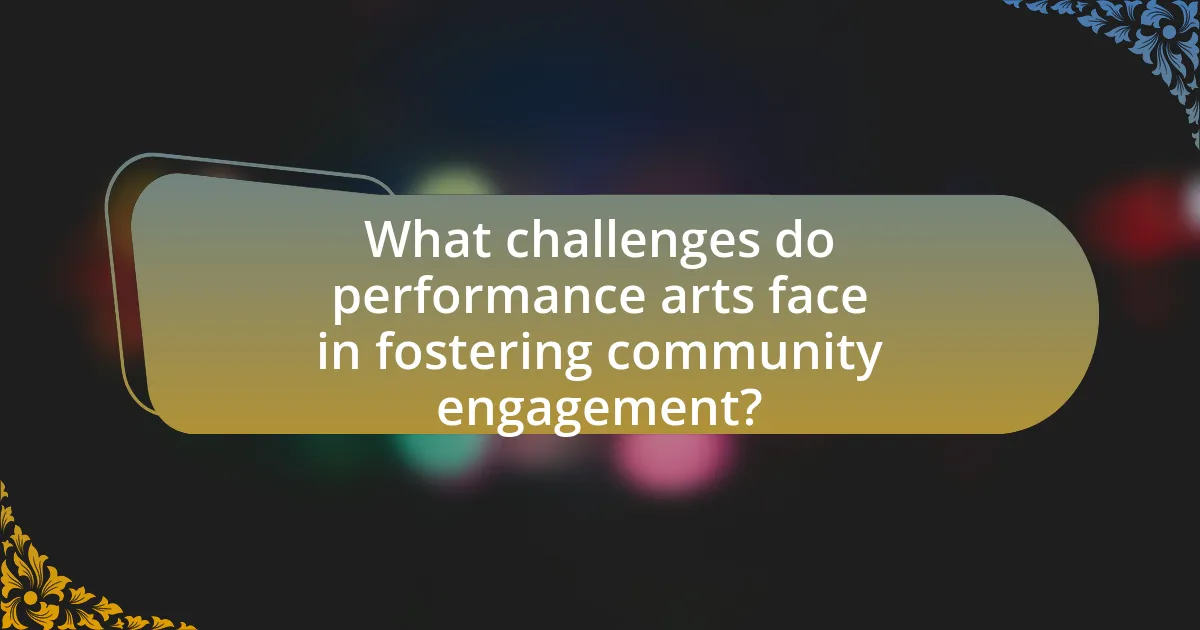
What challenges do performance arts face in fostering community engagement?
Performance arts face several challenges in fostering community engagement, primarily including accessibility, funding limitations, and cultural relevance. Accessibility issues arise when performances are not easily reachable for diverse community members, whether due to location, cost, or physical barriers. Funding limitations restrict the ability of performance arts organizations to produce events that resonate with the community, often leading to a reliance on grants or sponsorships that may not align with local interests. Cultural relevance is another significant challenge, as performance arts must reflect the diverse backgrounds and experiences of the community to engage effectively; failure to do so can result in disconnection and lack of participation. These challenges are supported by studies indicating that communities with higher accessibility and culturally relevant programming see increased engagement and attendance in performance arts events.
How can accessibility issues be addressed in performance arts?
Accessibility issues in performance arts can be addressed by implementing inclusive design practices, such as providing wheelchair access, offering sign language interpretation, and ensuring sensory-friendly environments. These measures enhance participation for individuals with disabilities, as evidenced by the National Endowment for the Arts, which reports that accessible venues increase audience diversity and engagement. Additionally, training staff on disability awareness and creating programs tailored for various needs can further promote inclusivity, thereby fostering a sense of community among diverse audiences.
What strategies can be implemented to reach underserved communities?
To reach underserved communities, strategies such as building partnerships with local organizations, utilizing culturally relevant programming, and employing community-based outreach methods can be implemented. Building partnerships with local organizations, such as schools, churches, and non-profits, allows for leveraging existing trust and networks within the community. Culturally relevant programming ensures that the performance arts resonate with the community’s values and experiences, increasing participation and engagement. Community-based outreach methods, including door-to-door campaigns and social media engagement, effectively raise awareness and invite participation in events. These strategies have been shown to enhance access and foster a sense of belonging, as evidenced by initiatives like the National Endowment for the Arts’ “Our Town” program, which supports creative placemaking projects that engage underserved populations.
How can performance arts combat stereotypes and promote inclusivity?
Performance arts can combat stereotypes and promote inclusivity by providing diverse representations and fostering dialogue among different communities. Through performances that showcase varied cultural narratives, artists challenge prevailing stereotypes and encourage audiences to engage with perspectives outside their own. For instance, productions like “Hamilton” have redefined historical narratives by featuring a racially diverse cast, which not only highlights underrepresented voices but also invites discussions about race and identity in America. Additionally, community-based theater initiatives often involve local participants, allowing marginalized groups to share their stories and experiences, thus creating a platform for inclusivity and understanding. This approach has been supported by studies indicating that exposure to diverse narratives in the arts can reduce prejudice and enhance empathy among audiences.
What are some best practices for successful community engagement through performance arts?
Successful community engagement through performance arts involves creating inclusive, accessible, and participatory experiences. Engaging local artists and community members in the planning and execution of performances fosters ownership and relevance, as seen in initiatives like the “Community Arts Program” in New York, which increased local participation by 40% over three years. Additionally, offering workshops and interactive sessions allows community members to actively participate, enhancing their connection to the art form. Research indicates that communities with strong performance arts programs report higher levels of social cohesion and civic engagement, as demonstrated by a study from the National Endowment for the Arts, which found that arts participation correlates with increased community involvement.
How can feedback from community members improve performance art initiatives?
Feedback from community members can significantly enhance performance art initiatives by ensuring that the artistic expressions resonate with the audience’s values and preferences. Engaging with community feedback allows artists and organizers to tailor performances to reflect local culture, address relevant social issues, and meet the audience’s expectations. For instance, a study by the National Endowment for the Arts found that community involvement in the arts leads to increased attendance and participation, demonstrating that when community voices are heard, the initiatives become more relevant and impactful. This alignment fosters a sense of ownership and pride among community members, ultimately leading to sustained support and engagement in performance art initiatives.
What are the key elements of a successful community performance event?
The key elements of a successful community performance event include clear objectives, community involvement, effective promotion, and logistical planning. Clear objectives ensure that the event aligns with the community’s interests and goals, fostering engagement. Community involvement, such as participation from local artists and volunteers, enhances ownership and connection to the event. Effective promotion through various channels, including social media and local partnerships, increases attendance and awareness. Logistical planning, which encompasses venue selection, scheduling, and resource allocation, is crucial for a smooth execution. These elements collectively contribute to the event’s success by creating an inclusive and engaging atmosphere that resonates with the community.
